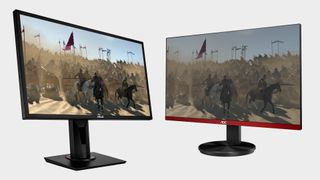Nvidia's frame rate boosting DLSS tech is now a simple download for any game developer
There's surely no reason for devs not to implement it now?

The Nvidia Deep Learning Super Sampling (DLSS) SDK has now been made freely available for anyone to download from its site. Where once you had to apply to use Nvidia's funky machine learning game enhancer, now it's just a simple download.
That means, theoretically, it should be easier than ever for game developers to start implementing DLSS into their games. We've seen how good it looks in Red Dead Redemption 2, among plenty of others now. Now there's no excuse not to squeeze in some performance boosting AI goodness into your next title.
There are three options for aspiring DLSS devs: either grab the full DLSS SDK 2.2.1 download from Nvidia itself, snag the Unreal Engine 5 and 4.26 plugins from the marketplace, or use it natively in the Unity 2021.2 beta.
DLSS is probably the most important feature Nvidia has produced in recent times. It uses advanced machine learning to understand what a game should look like in high fidelity, and then uses your GPU's AI chops to reconstruct a lower resolution input into a great-looking experience with higher frame rates than at a native res.
It's worth noting that while DLSS was initially tied into Nvidia's push for real-time ray tracing in games, as the feature which made the punitive performance hit palatable, we're increasingly seeing it used completely independently in games just to increase frame rates on its own.
AMD has its own spatial upscaling and sharpening tool, called FidelityFX Super Resolution, which offers a modicum of the benefits of DLSS, but on a platform agnostic basis. Nvidia's feature is just for Nvidia cards, because of capitalism, and because it does now use those silicon-based Tensor cores in its GPUs.
Nvidia has also this week shown RTX features, including DLSS and ray tracing, running on an Arm CPU system with a GeForce GPUs. There's got to be an Arm-based GeForce gaming laptop coming soon, right?
The biggest gaming news, reviews and hardware deals
Keep up to date with the most important stories and the best deals, as picked by the PC Gamer team.

Best gaming monitor: pixel-perfect panels for your PC
Best high refresh rate monitor: screaming quick screens
Best 4K monitor for gaming: when only high-res will do
Best 4K TV for gaming: big-screen 4K PC gaming
Anyway, Nvidia's potential feature install base is only growing, with Proton support for DLSS (for Linux gamers running Windows games), and now native Linux support on x86 too.
Nvidia is also updating DLSS itself for both devs and players alike. There will now be a sharpening slider optionally available for developers to drop into their games, which will allow the end user to make images softer or sharper depending on their preference. DLSS is also getting a new Auto mode, which will pick an optimal DLSS setting based on the preferred resolution. That means for 1440p and under you get set to 'Quality', at 4K you're set at 'Performance', and at 8K you're given 'Ultra Performance.'

Dave has been gaming since the days of Zaxxon and Lady Bug on the Colecovision, and code books for the Commodore Vic 20 (Death Race 2000!). He built his first gaming PC at the tender age of 16, and finally finished bug-fixing the Cyrix-based system around a year later. When he dropped it out of the window. He first started writing for Official PlayStation Magazine and Xbox World many decades ago, then moved onto PC Format full-time, then PC Gamer, TechRadar, and T3 among others. Now he's back, writing about the nightmarish graphics card market, CPUs with more cores than sense, gaming laptops hotter than the sun, and SSDs more capacious than a Cybertruck.
Most Popular







